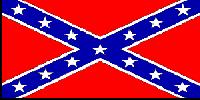The
American Civil War
The men of the 8th Virginia knew the terrain well, and took positions
along a ridge overlooking Ball's Bluff, as Yankee troops reached the
plateau. The thin line of Virginians were mostly seasoned
hunters— expert sharpshooters. Some set up behind the shelter
of
tree stumps, some climbed trees for better sightings and others
concealed themselves in tall grass and gullies. Suddenly, they opened a
withering fire on an advancing sea of blue coats, felling officer after
officer to create confusion in Federal ranks. But still the
Massachusetts, California and New York regiments pressed forward to the
bluff, bent on exploiting superior numbers. For three hours the
Virginians repulsed them, until ammunition was nearly exhausted
—
then desperately searched among the dead for more. The Virginians'
leader Colonel Eppa Hunton dispatched the message, "My powder is out;
what shall I do?" to General "Old Shanks" Evans, who replied, "Fix
bayonets and run 'em into the river!"
Just as Union troops were mounting an all-out assault to flank the little ridge, the 18th Mississippi arrived with blood-curdling rebel yells. The crash of hundreds of muskets blasted the Union ranks, as their colorful leader Colonel Edward D. Baker (a U.S. Senator and close friend of Lincoln) was shot down at close quarters by a young defender. Now, as the Virginians charged forward, Federals pushed to the rear, some tumbling off the bluff to their doom in the river. The humiliating Union defeat prompted a congressional investigation and the temporary imprisonment of the commanding general, Charles P. Stone.
The hard-fighting regiment that would come to be known as the "Old Bloody Eighth" was organized in Leesburg, Virginia, in May, 1861. Most were from the surrounding area, but one of its most famous soldiers was not: Randolph Abbott Shotwell, whose autobiography included stirring accounts of the 8th Virginia in battle. The Virginia-born Shotwell was a 17-year-old student in Pennsylvania when the Civil War broke out. After heading south, he joined up with the 8th Virginia because it was the first Confederate regiment he found. He fought with the 8th Virginia until his capture at Cold Harbor in 1864.
The 8th Virginia quickly covered itself in glory at First Manassas
(Bull Run), the first full-scale battle in Virginia, fought on July
21,1861. General Beauregard cited their gallantry for restoring a line
that had cracked under a powerful Union assault on Henry Hill, then
staunchly defending the vital Southern flank around Robinson House near
the stone bridge (see map to right). A few months later, the 8th
Virginia's fierce defense of its home ground at Leesburg (Ball's Bluff)
made them a legend in the Army of Northern Virginia. They would be in
the brigades of Generals Gracie, Pickett, and Garnett, experiencing
some of the most horrendous losses of the war. They were in the thick
of the fighting at Sharpsburg and Gettysburg, where the 8th Virginia
lost about 90 percent of its depleted number of 193 men. Later the 8th
Virginia was attached to the Department of Richmond, making Union
forces pay dearly at Cold Harbor and fighting to the last in Petersburg
trenches. At Appomattox, only one surgeon and 11 privates of the 8th
Virginia surrendered.
In his autobiography, Lieutenant Shotwell details many of the terrible hardships endured by men of the 8th Virginia, who continued to fight heroically although constantly lacking in food and clothing. As if symbolic of the heavy blood-letting suffered by the hard-fighting 8th Virginia, the red field of its battle colors that so often inspired valor faded to white. Today the 8th Virginia's proud flag is displayed at the Museum of the Confederacy.

8th Virginia Infantry Regiment
Some 30 miles up the Potomac from Washington nestled the town of
Leesburg, where the 8th Virginia Infantry Regiment had formed when war
erupted. Now, in October of 1861, General George B. McClellan sensed an
easy victory when he heard Confederate troops were evacuating the area.
On October 21, four Union regiments were gradually ferried across the
Potomac into Virginia... and the 8th Virginia Infantry Regiment rushed
forward to defend hearth and home at Leesburg.Determined Defense Sparks a Union Disaster at Ball's Bluff
Just as Union troops were mounting an all-out assault to flank the little ridge, the 18th Mississippi arrived with blood-curdling rebel yells. The crash of hundreds of muskets blasted the Union ranks, as their colorful leader Colonel Edward D. Baker (a U.S. Senator and close friend of Lincoln) was shot down at close quarters by a young defender. Now, as the Virginians charged forward, Federals pushed to the rear, some tumbling off the bluff to their doom in the river. The humiliating Union defeat prompted a congressional investigation and the temporary imprisonment of the commanding general, Charles P. Stone.
The hard-fighting regiment that would come to be known as the "Old Bloody Eighth" was organized in Leesburg, Virginia, in May, 1861. Most were from the surrounding area, but one of its most famous soldiers was not: Randolph Abbott Shotwell, whose autobiography included stirring accounts of the 8th Virginia in battle. The Virginia-born Shotwell was a 17-year-old student in Pennsylvania when the Civil War broke out. After heading south, he joined up with the 8th Virginia because it was the first Confederate regiment he found. He fought with the 8th Virginia until his capture at Cold Harbor in 1864.
One of the Most Active and Devastated Southern Regiments
In his autobiography, Lieutenant Shotwell details many of the terrible hardships endured by men of the 8th Virginia, who continued to fight heroically although constantly lacking in food and clothing. As if symbolic of the heavy blood-letting suffered by the hard-fighting 8th Virginia, the red field of its battle colors that so often inspired valor faded to white. Today the 8th Virginia's proud flag is displayed at the Museum of the Confederacy.